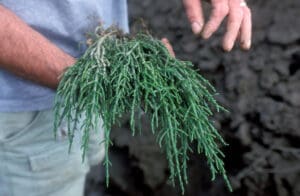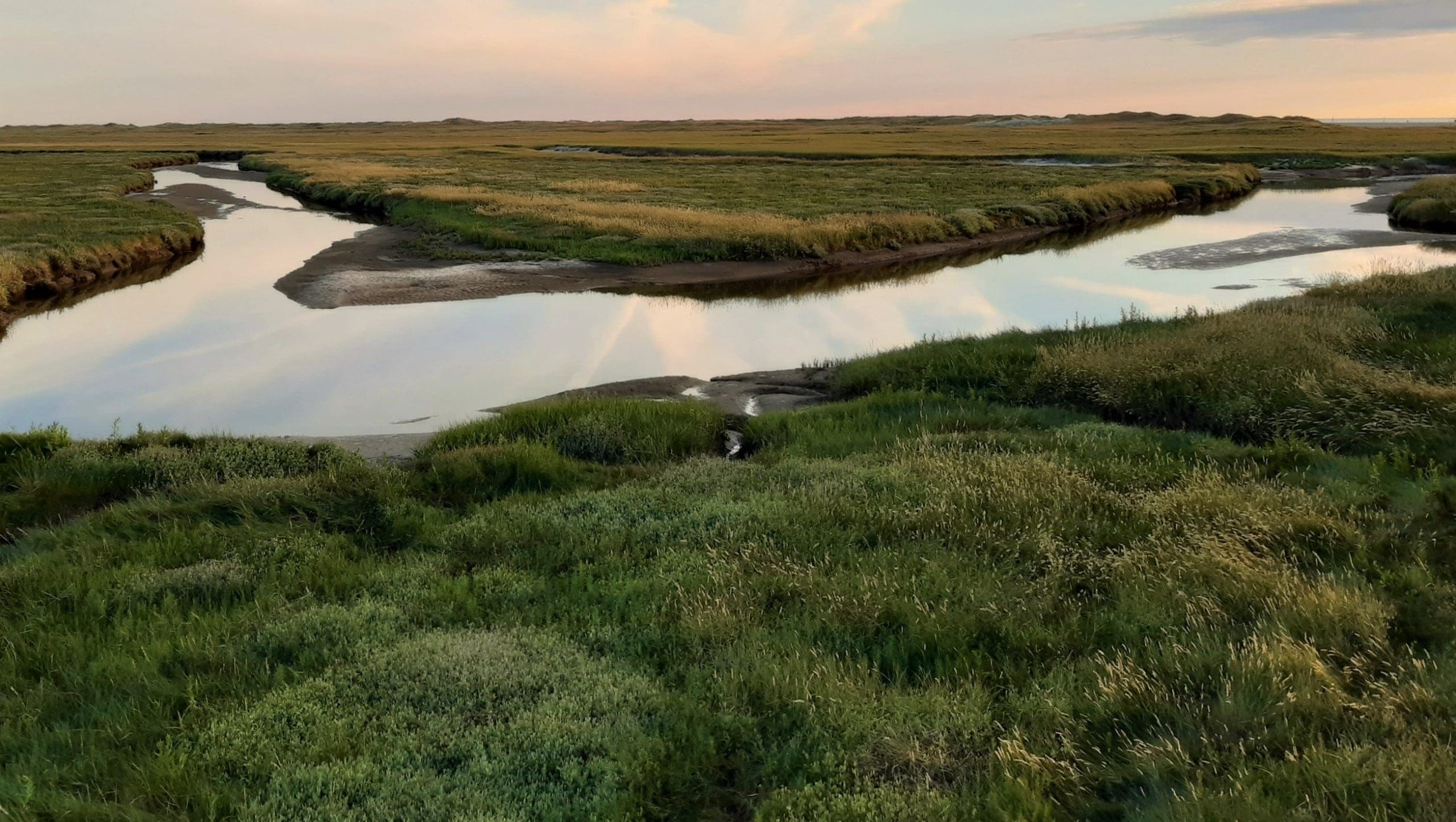It’s come a long way. Time was when you’d see little sprigs of greenery, overlooked and unassuming, languishing in the display cabinet of your local fishmonger – a mere foil for the fish. Now, in our age of culinary enlightenment, what was once dubbed the ‘poor man’s asparagus’ is revered in many of the best London restaurants (asparagus seems positively ordinary by comparison). Some even fly it in from far-flung locales, when with a decent pair of waders, it’s there for the taking on home turf.
We’re talking samphire, of course (marsh samphire, to be precise). Nothing says summer in North Norfolk quite like a freshly picked bag of the stuff. And, like many things in Norfolk, there’s a knack to pronouncing it (‘sam-fur’, to locals). Here, this ever more desirable sea vegetable – delicate, succulent and sensational with fish, carpets the coastal salt marshes from June to September. This year is a particularly good one, thanks to all that spring and early summer rain (every cloud…).
 Unlike the more common-or-garden greens stocked by a certain middle-class supermarket (samphire isn’t to be found on your average shelf), it’s still an uncultivated crop – which puts it in a category of almost one. Perhaps that’s what adds to its allure – the call of the wild, in vegetable form. Guaranteed organic. Guaranteed to impress when cooking for friends.
Unlike the more common-or-garden greens stocked by a certain middle-class supermarket (samphire isn’t to be found on your average shelf), it’s still an uncultivated crop – which puts it in a category of almost one. Perhaps that’s what adds to its allure – the call of the wild, in vegetable form. Guaranteed organic. Guaranteed to impress when cooking for friends.
Aficionados wax lyrical about Salicornia Europaea, to give it its proper name. The crisp texture! The briny tang! And the seasonality that makes it all the more anticipated. Given the abundance of samphire-friendly mudflats, marshes and shallow creeks along the North Norfolk coast, this is considered the best place in the UK to find it.
North Norfolk restaurants worth their salt will serve samphire in season, in some way, shape or form. Stanley’s, The Harper’s restaurant, is no exception. Always ones for foraging, the chefs will often harvest it along nearby creeks before coming in of a morning. You have to know where to look, of course, though you’ll often come across locals who do – selling it by the bag from their front gardens as you pootle along the coast road. Said locals are lucky enough to own property backing the beaches and salt marshes of this unspoiled swathe. They’re among a privileged few who’ve been enjoying Norfolk’s bumper crop every summer since before the rest of us had really caught on. Now, it seems, the word is out.
So, what do they do with those plump, green stalks so full of eastern (make that East Anglian) promise? Keeping it simple is a useful rule of thumb. “Anything more than lightly steamed or warmed in a drizzle of butter and it will lose its character, but when delivered in a fresh and uncomplicated way, it’s perfect partnered with simply grilled whole fish on the Josper, or shellfish”, says Stuart Paterson, who heads up The Harper’s kitchen team. Simplicity is an ethos put to wonderful effect in the form of a rather moreish Lobster and Samphire Mac ‘n Cheese – comfort food with an inventive flourish that’s fast becoming a Harper signature. The samphire is added late on to lose none of its salty punch.
 Those who know North Norfolk know Gurneys, the granddaddy of fishmongers, in beautiful Burnham Market. If you’re looking to stock up on samphire but don’t fancy foraging, it’s probably the best place to pick up supplies – at a snip of the price a London fishmonger would charge. Mike Gurney’s been in the business for over forty years, since the days he sold oysters from a hole in the wall in nearby Brancaster, so there’s not a lot he can’t tell you about what goes with fish.
Those who know North Norfolk know Gurneys, the granddaddy of fishmongers, in beautiful Burnham Market. If you’re looking to stock up on samphire but don’t fancy foraging, it’s probably the best place to pick up supplies – at a snip of the price a London fishmonger would charge. Mike Gurney’s been in the business for over forty years, since the days he sold oysters from a hole in the wall in nearby Brancaster, so there’s not a lot he can’t tell you about what goes with fish.
He could tell you, too, that samphire is also known as glasswort, owing to its erstwhile use in glassmaking as a source of sodium. In sixteenth-century England, it was dried, then burnt in batches to form soda ash – the favoured flux of immigrant European glassmakers.
Fast forward 500 years and they’d likely feel quite at home in Langham. The North Norfolk village we call home has a proud glassmaking history – and with the sea just up the road, a ready supply of samphire every summer.
To recreate the taste of a North Norfolk summer in your own kitchen, simply boil or steam a handful gently for no more than three minutes, drain immediately, and serve with a knob of butter and a wedge of lemon. Try it as a side with seafood, or just on its own.
Suffice to say, no salt is needed. Nothing tastes of the sea more than samphire.







